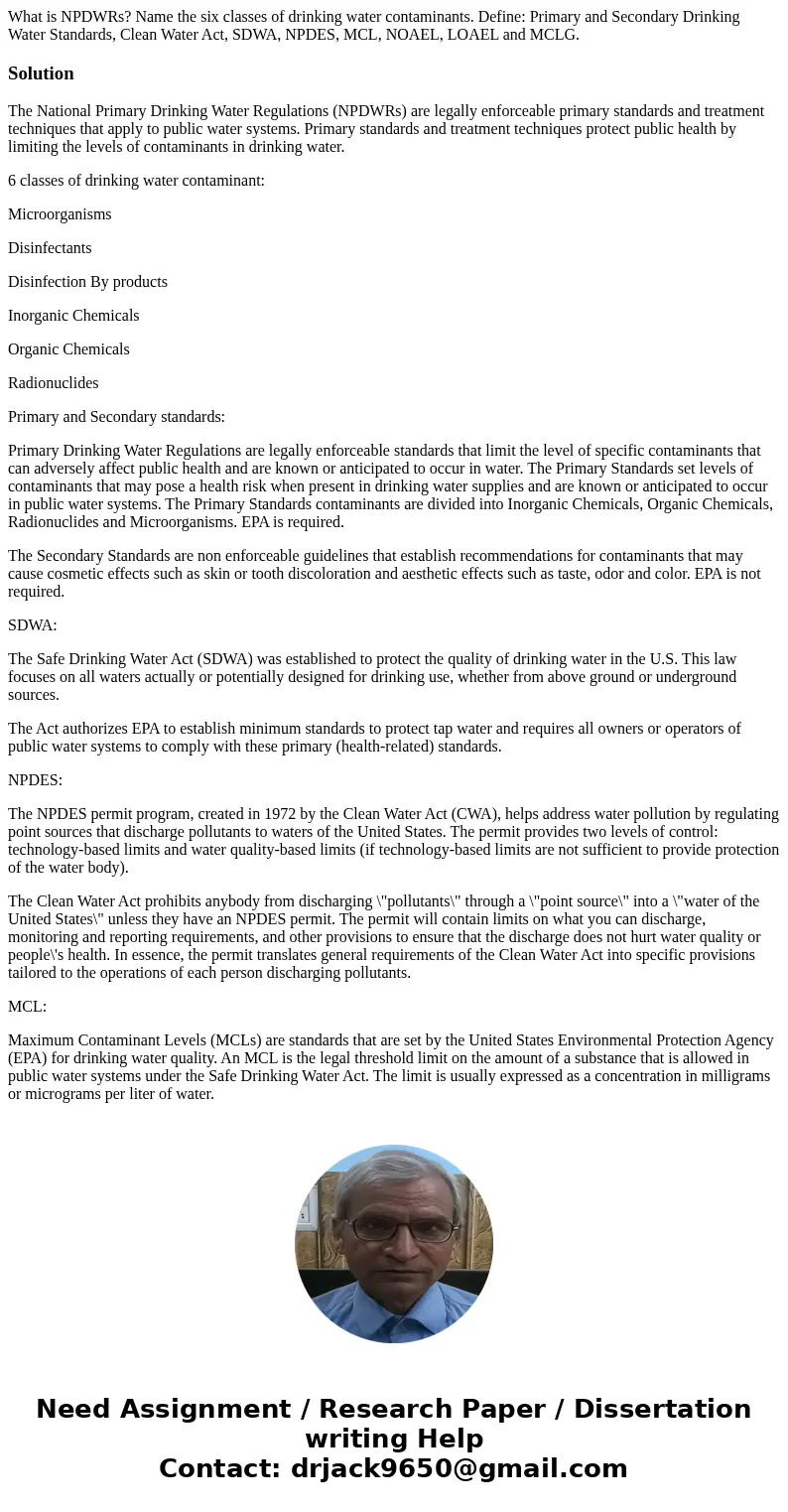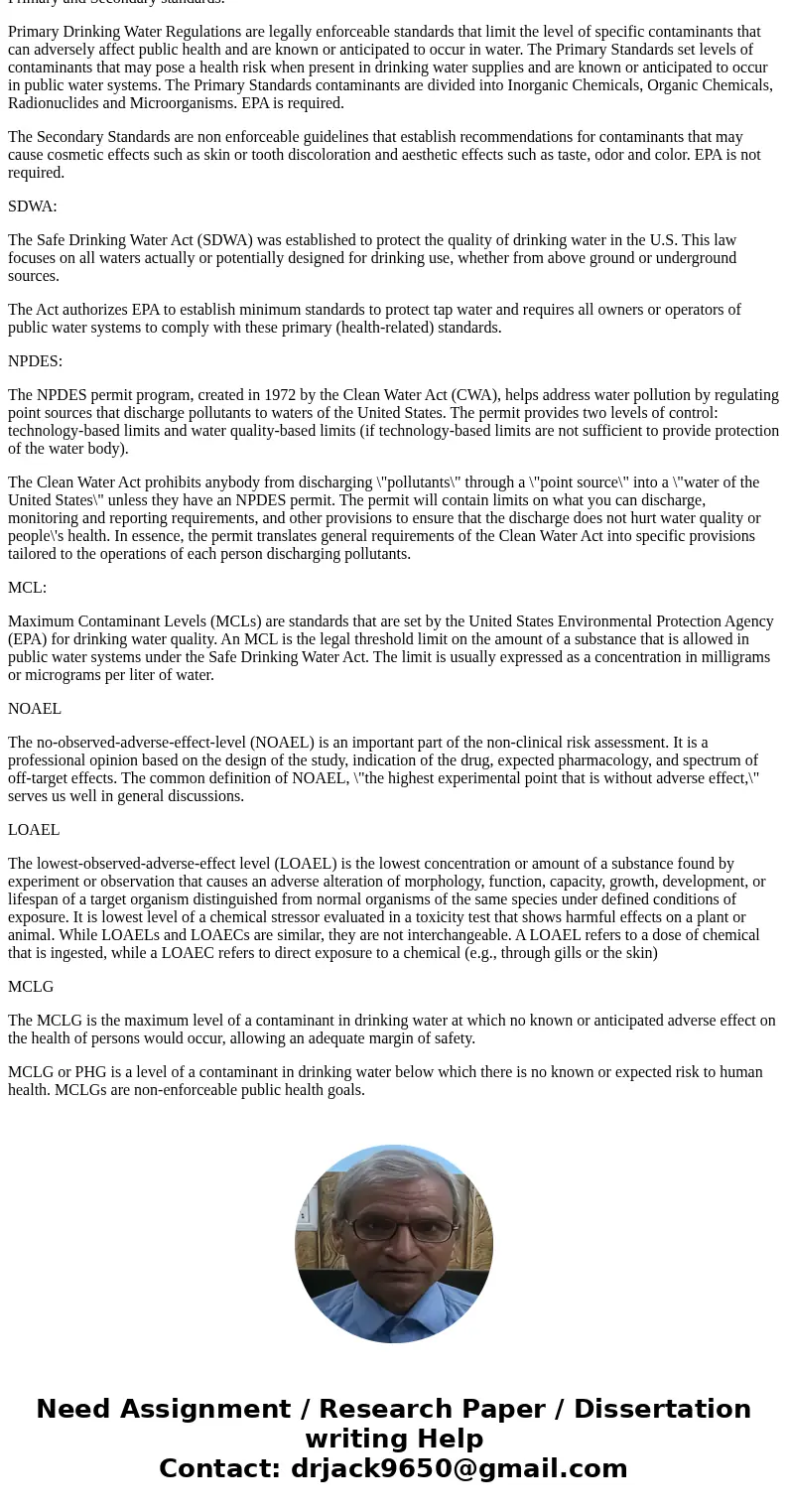What is NPDWRs Name the six classes of drinking water contam
What is NPDWRs? Name the six classes of drinking water contaminants. Define: Primary and Secondary Drinking Water Standards, Clean Water Act, SDWA, NPDES, MCL, NOAEL, LOAEL and MCLG.
Solution
The National Primary Drinking Water Regulations (NPDWRs) are legally enforceable primary standards and treatment techniques that apply to public water systems. Primary standards and treatment techniques protect public health by limiting the levels of contaminants in drinking water.
6 classes of drinking water contaminant:
Microorganisms
Disinfectants
Disinfection By products
Inorganic Chemicals
Organic Chemicals
Radionuclides
Primary and Secondary standards:
Primary Drinking Water Regulations are legally enforceable standards that limit the level of specific contaminants that can adversely affect public health and are known or anticipated to occur in water. The Primary Standards set levels of contaminants that may pose a health risk when present in drinking water supplies and are known or anticipated to occur in public water systems. The Primary Standards contaminants are divided into Inorganic Chemicals, Organic Chemicals, Radionuclides and Microorganisms. EPA is required.
The Secondary Standards are non enforceable guidelines that establish recommendations for contaminants that may cause cosmetic effects such as skin or tooth discoloration and aesthetic effects such as taste, odor and color. EPA is not required.
SDWA:
The Safe Drinking Water Act (SDWA) was established to protect the quality of drinking water in the U.S. This law focuses on all waters actually or potentially designed for drinking use, whether from above ground or underground sources.
The Act authorizes EPA to establish minimum standards to protect tap water and requires all owners or operators of public water systems to comply with these primary (health-related) standards.
NPDES:
The NPDES permit program, created in 1972 by the Clean Water Act (CWA), helps address water pollution by regulating point sources that discharge pollutants to waters of the United States. The permit provides two levels of control: technology-based limits and water quality-based limits (if technology-based limits are not sufficient to provide protection of the water body).
The Clean Water Act prohibits anybody from discharging \"pollutants\" through a \"point source\" into a \"water of the United States\" unless they have an NPDES permit. The permit will contain limits on what you can discharge, monitoring and reporting requirements, and other provisions to ensure that the discharge does not hurt water quality or people\'s health. In essence, the permit translates general requirements of the Clean Water Act into specific provisions tailored to the operations of each person discharging pollutants.
MCL:
Maximum Contaminant Levels (MCLs) are standards that are set by the United States Environmental Protection Agency (EPA) for drinking water quality. An MCL is the legal threshold limit on the amount of a substance that is allowed in public water systems under the Safe Drinking Water Act. The limit is usually expressed as a concentration in milligrams or micrograms per liter of water.
NOAEL
The no-observed-adverse-effect-level (NOAEL) is an important part of the non-clinical risk assessment. It is a professional opinion based on the design of the study, indication of the drug, expected pharmacology, and spectrum of off-target effects. The common definition of NOAEL, \"the highest experimental point that is without adverse effect,\" serves us well in general discussions.
LOAEL
The lowest-observed-adverse-effect level (LOAEL) is the lowest concentration or amount of a substance found by experiment or observation that causes an adverse alteration of morphology, function, capacity, growth, development, or lifespan of a target organism distinguished from normal organisms of the same species under defined conditions of exposure. It is lowest level of a chemical stressor evaluated in a toxicity test that shows harmful effects on a plant or animal. While LOAELs and LOAECs are similar, they are not interchangeable. A LOAEL refers to a dose of chemical that is ingested, while a LOAEC refers to direct exposure to a chemical (e.g., through gills or the skin)
MCLG
The MCLG is the maximum level of a contaminant in drinking water at which no known or anticipated adverse effect on the health of persons would occur, allowing an adequate margin of safety.
MCLG or PHG is a level of a contaminant in drinking water below which there is no known or expected risk to human health. MCLGs are non-enforceable public health goals.


 Homework Sourse
Homework Sourse